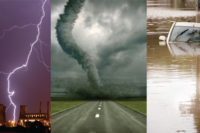Outdoor workers are exposed to the elements and in danger from frostbite or hypothermia during winter weather, whether or not they work near traffic areas.
According to National Weather Service, about 70 percent of injuries during winter storms result from vehicle accidents, and about 25 percent of injuries result from being caught out in the storm. Keeping safe while working in inclement weather requires not only being seen in poor visibility conditions, but also protection from the elements.
The orange or yellow safety vest is a familiar sight on road-related projects, but it can fall short of optimal visibility and comfort in rough weather conditions. Many times workers don’t fasten their vests closed, so they do not get 360-degree protection. If they wear their vests open, there is also the potential danger of the vest getting caught on a piece of equipment.
To combine safety and comfort, some manufacturers have focused on incorporating ANSI 107 high-visibility standards into new apparel designs that allow for layering and flexibility.
No excuses
More workers are now subject to the high-visibility standards as a result of 2009 revisions to the Manual on Uniform Traffic Control Devices (MUTCD). All workers within the right of way or work zone must wear high-visibility apparel that meets ANSI 107 Performance Class 2 or Class 3 standards. This applies to all roads, not just federal-aid highways.
With ANSI 107 regulations requiring high-visibility gear in many more jobs than before, achieving worker compliance during winter months is an added challenge.
Workers often complain that high-visibility clothes including vests are not comfortable or get in their way. “I forgot” is often the excuse that is made. But, as an employer or safety executive, that excuse is not going to protect workers’ safety or protect a company from fines or lawsuits should an accident occur due to lack of high-visibility protection.
Some employers may make the mistake of believing that only high-visibility vests meet ANSI 107 and MUTCD compliance standards. As long as items like sweatshirts, jackets and suits meet ANSI standards, your workers are in compliance.
Added choices aid compliance
Most if not all traditional work wear styles are now available in ANSI 107 complaint designs. Replacing a traditional garment like a sweatshirt with a high visibility one can be a more comfortable alternative to wearing a vest over a sweatshirt. Without the vest, workers have increased freedom of movement, and are less likely to get caught on equipment because their clothing is worn close to the body, not open and loose. Like traditional work wear, high-visibility apparel is easy to clean and typically washed more often than vests helping to better maintain their look and performance. If a worker is more comfortable and clothing is easier to wear, it is more likely it will get worn.
Layering allows workers to easily change what they wear based on weather conditions. In colder weather, dressing in layers such as combining a high-visibility sweatshirt and jacket helps trap body heat. However, sweating can leave workers wet all day and unprotected from the cold, so layering allows them to adjust as needed. Layering with high-visibility apparel ensures that as the layers come off, the worker remains protected.
More options than ever
The key to these new all-in-one high-visibility products is comfort and flexibility. When considering what kind of high-visibility product to buy, think about the warmth-to-weight ratio — look for a garment that keeps the wearer warm with the lightest weight materials possible. Other considerations include pockets, draw cords and take-up features to meet the needs of different wearers and work site requirements.
Manufacturers have taken the materials and designs used for sports and recreation clothing, and combined those with the needs for work wear. High-visibility softshell jackets are made from the same materials used by hikers, mountain bikers and skiers. Softshell material is ideal for a wide variety of work environments.
Today’s high-visibility choices include waterproof, insulated Class 3 bomber jackets for the coldest weather applications. Other options include Class 3 multipurpose, breathable jackets that provide waterproof and windproof comfort. With removable liners and sleeves, these all-in-one jackets are designed for year-round use, taking the place of a vest, plus a windbreaker, winter jacket and rain jacket.
High-visibility jackets, sweatshirts and t-shirts are available though most safety and industrial distributors and can also be found in many work wear stores. For more information on the ANSI 107 standard, visit the website for International Safety Equipment Association (ISEA), the trade organization that publishes the standard. There is also a buyer’s guide available on the website that lists a number of manufacturers for ANSI 107 compliant apparel.

